This chapter covers requirements for lighting in multifamily buildings, including dwelling units, interior common use areas, and outdoor areas. Requirements for lighting in nonresidential spaces in mixed use buildings are covered in Chapter 5 (Nonresidential Manual).
Lighting requirements in multifamily buildings vary between dwelling units, common use areas and outdoor areas. For dwelling units, all the lighting requirements are mandatory. There are luminaire requirements and lighting control requirements for dwelling unit lighting installations. For lighting in common use areas and outdoor areas, requirements include mandatory, prescriptive and performance options, and calculations of lighting power and maximum lighting power thresholds.
Table 11-62 provides an overview of the location of the lighting requirements in the 2022 Energy Code by system building type and where descriptions reside in this document.
This section summarizes changes to the requirements for multifamily lighting for the 2022 Energy Code.
- Compiles all lighting requirements for all parts of multifamily buildings into a standalone Multifamily Standard. Requirements for dwelling unit lighting largely align with the single-family residential lighting standards, and requirements for common use areas and outdoor areas in multifamily buildings largely align with the nonresidential lighting standards.
- Eliminates building proportion thresholds for common use areas and consolidates all requirements for multifamily common use areas under a single system.
- Eliminates all thresholds for variable outdoor lighting requirements and consolidates multifamily outdoor lighting requirements under a single system.
All requirements relating to lighting within dwelling units and any outdoor lighting controlled from within dwelling units are mandatory. All requirements for dwelling unit lighting align with the applicable single-family residential lighting requirements. Requirements for dwelling unit lighting are described in the sections below.
The Standards for dwelling unit lighting require all permanently installed luminaires to be high luminous efficacy, as specified in §160.5(a). Permanently installed lighting is defined in §100.1 and includes:
-
Lighting attached to walls, ceilings, or columns.
-
Track and flexible lighting systems.
-
Lighting inside permanently installed cabinets.
-
Lighting attached to the top or bottom of permanently installed cabinets.
-
Lighting attached to ceiling fans.
-
Lighting integral to exhaust fans.
-
Lighting integral to garage door openers if it is used as general lighting, is switched independently from the garage door opener, and does not automatically turn off after a pre-determined amount of time.
The following are examples of non-permanently installed lighting:
-
Portable lighting as defined by §100.1 (including, but not limited to, table and freestanding floor lamps with plug-in connections)
-
Lighting installed by the manufacturer in refrigerators, stoves, microwave ovens, exhaust hoods for cooking equipment
Table 11-63 summarizes the requirements for dwelling unit high luminous efficacy luminaires. There are luminaires automatically classified as high luminous efficacy, luminaires that must use JA8-certified light sources or lamps, and recessed downlight luminaires in ceilings. These categories are described in more detail in the following sections.
High Luminous Efficacy Luminaires* | JA8 High Luminous Efficacy Lighting – Lamps and Light Sources that must be JA8-certified | Recessed Downlight Luminaires in Ceilings |
-LED light sources installed outdoors -Inseparable solid-state lighting (SSL) luminaires containing colored light sources for decorative lighting purpose -Pin-based linear fluorescent luminaires or compact fluorescent luminaires using electronic ballasts -High intensity discharge (HID) light sources including pulse-start metal halide luminaires and high pressure sodium luminaires -Luminaires with induction lamp and hardwired high frequency generator -Ceiling fan light kits subject to federal appliance regulations | -Light sources installed in ceiling recessed downlight luminaires. -LED luminaires with integral sources -Screw-based LED lamps (A-lamps, PAR lamps, etc.) -Pin-based LED lamps (MR-16, AR-111, etc.) -Any light source or luminaire not listed elsewhere in this table | -Must not have screw-based sockets -Must contain JA8 -certified light sources |
Luminaires in any of the following categories are classified high luminous efficacy and do not have to comply with the requirements of Reference Joint Appendix JA8 (refer to next section for details).
- LED luminaires installed outdoors
- Inseparable solid-state lighting (SSL) luminaires containing colored light sources for decorative lighting purpose.
- Pin-based linear fluorescent luminaires or compact fluorescent luminaires using electronic ballasts
- High intensity discharge (HID) luminaires including pulse-start metal halide luminaires and high pressure sodium luminaires
- Luminaires with induction lamp and hardwired high frequency generator
- Ceiling fan light kits that are subject to federal appliance regulations.
Luminaires not listed in the previous section must have an integral light source or removable lamp that meets the performance requirements of JA8. The requirements in JA8 allow any type of light source, such as LED, as long as it provides energy-efficient lighting and meets minimum performance characteristics. In addition to setting minimum efficacy requirements (lumens/Watt), JA8 establishes performance requirements that ensure accurate color rendition, dimmability, and reduced noise and flicker during operation.
Luminaires with integral sources, such as LED luminaires, must be certified to the Energy Commission as meeting the JA8 requirements. Luminaires that have changeable lamps (such as screw-base luminaires) must be installed with JA8-certified lamps.
Luminaires and lamps that are certified to the Energy Commission must be marked on the product as described in JA8. Lamps that will be installed in elevated temperature applications such as in enclosed luminaires must have a JA8-2022-E marking to indicate that the product has passed the more stringent ENERGY STAR Elevated Temperature Life test.
Luminaires that can be classified as high luminous efficacy by meeting the requirements of JA8 include:
- LED luminaires with integral light sources that are certified to the Energy Commission.
- Ceiling recessed downlight luminaires with JA8 certified light sources (the luminaire must not contain screw-based lamp sockets).
- Screw-based luminaires with JA8-certified lamps.
- Low-voltage pin-based luminaires with JA8-certified lamps.
Almost any luminaire can be classified as high luminous efficacy, as long as the luminaire is installed with a JA8 certified lamp or light source. The exception is recessed downlight luminaires in ceilings, which must meet additional requirements.
The Energy Commission maintains a database of certified JA8 certified luminaires, lamps, and light sources. The database can be accessed using a Quick Search Tool or an Advanced Search.
In addition to the high luminous-efficacy requirements described above, there are several additional requirements for dwelling unit downlight luminaires that are recessed in ceilings.
Recessed downlight luminaires are limited to specific light sources and lamp types that may be used. Recessed downlight luminaires:
- Must contain light sources that are JA8-certified.
- Must not contain screw-based lamps.
- Must not contain light sources that are labeled not for use in enclosed luminaires or not for use in recessed luminaires.
All recessed downlight luminaires must contain a light source or lamp that is JA8-certified, such as an integral LED source or LED lamp. Screw-based lamps such as LED A-lamps or LED PAR lamps are not allowed. Pin-based lamps such as LED MR-16 lamps are allowed in recessed luminaires as long as they are JA8-certified.
In addition to the light source and lamp requirements listed, recessed downlight luminaires in ceilings must meet all the following requirements:
- Have a label that certifies the luminaire is airtight with air leakage less than 2.0 cubic ft. per minute at 75 Pascals when tested in accordance with ASTM E283 (exhaust fan housings with integral lighting are not required to be certified airtight).
- Be sealed with a gasket or caulk between the luminaire housing and ceiling, and have all air leak paths between conditioned and unconditioned spaces sealed with a gasket or caulk, or be installed per manufacturer’s instructions to maintain airtightness between the luminaire housing and ceiling.
- Meet the clearance and installation requirements of California Electrical Code Section 410.116 for recessed luminaires which requires the following.
- A recessed luminaire that is not identified for contact with insulation, non-Type IC, must have all recessed parts spaced not less th½1/2 inch from combustible materials. The points of support and the trim finishing off the openings in the ceiling must be permitted to be in contact with combustible materials.
- A recessed luminaire that is identified for contact with insulation, Type IC, must be permitted to be in contact with combustible materials at recessed parts, points of support, and portions passing through or finishing off the opening in the building structure.
- Thermal insulation must not be installed above a recessed luminaire or within 3 inches of the recessed lumina’re's enclosure, wiring compartment, ballast, transformer, LED driver, or power supply unless the luminaire is identified as Type IC for insulation contact.
Luminaires that meet the air leakage requirement or luminaires that are Type IC rated will have this information listed on luminaire cut sheets or packaging. Contractors are responsible for ensuring that luminaires are properly sealed to prevent air leakage between the luminaire housing and ceiling.
Recessed luminaires that are marked for use in fire-rated installations and recessed luminaires installed in non-insulated ceilings are exempt from the air leakage requirement and sealing requirement, however, must meet all other requirements for recessed luminaires.
For enclosed luminaires and recessed luminaires other than ceiling-recessed downlights, the installed light source must be JA8 compliant and meet the elevated temperature requirement. The JA8-compliant lamps and light sources must be marked with “JA8-2022-E” to signify that they are suitable to be installed in an enclosed or recessed luminaire.
For screw-base luminaires to be installed in residential spaces, the installed lamps must be JA8 certified. Recessed downlight luminaires in ceilings cannot have screw base lamp sockets.
Navigation lighting such as night lights, step lights, and path lights must either:
- Be rated to consume no more than 4 watts; or
- Comply with luminaire efficacy requirement in §160.5(a)1A and Table 160.5-A.
Luminaires or light sources internal to drawers, cabinets, and linen closets must either:
- Have an efficacy of 45 lumens per watt or greater
- Comply with luminaire efficacy requirements in §160.5(a)1A and Table 160.5-A.
Light sources in drawers and cabinets with opaque fronts or doors must also have controls that automatically turn the light off when the drawer or door is closed.
Example 11-37: Screw-based luminaires
Question
I am using a screw-based luminaire that is rated to take a 60W lamp for lighting over a sink, and I plan to install a 10W LED lamp. Does it meet the dwelling unit lighting requirement for screw-based luminaires?
Answer
If the LED lamp is JA8-certified and marked JA8-2022 or JA8-2022-E, then it meets the dwelling unit lighting requirement for screw-based luminaires in §160.5(a)1B and Table 160.5-A.
Example 11-38: Kitchen Exhaust Hood Lighting
Question
I am installing an exhaust hood over my kitchen range that has lamps in it. Do these lamps have to be high efficacy?
Answer
This lighting is integrated into the appliance and does not have to meet the dwelling unit luminaire efficacy requirements for permanently installed lighting.
The number of blank electrical boxes that are more than five feet above the finished floor and do not contain a luminaire or other device must be no greater than the total number of bedrooms in the dwelling unit. These electrical boxes must be served by a dimmer, vacancy sensor control, low voltage wiring, or fan speed control.
As with the luminaire requirements described in the previous section, all dwelling unit lighting control requirements are mandatory.
Following are general requirements for how and where lighting controls must be implemented in multifamily dwelling units:
- Readily Accessible Manual Controls
All permanently installed luminaires must have readily accessible wall-mounted controls that permit the luminaires to be manually turned on and off. Per §100.1 Definitions, readily accessible is capable of being reached quickly for operation, repair, or inspection without requiring climbing or removing obstacles, or resorting to access equipment - Multiple Switches
A lighting circuit can be controlled by more than one switch, such as by three-way or four-way switches. For a lighting circuit with multiple switches, and where a dimmer or vacancy sensor has been installed to comply with §160.5(a), the following requirements must be met:- No controls must bypass the dimmer or vacancy sensor function.
- The dimmer or vacancy sensor must comply with the applicable requirements of §110.9(b).
- Energy Management Control Systems (EMCS) and Multiscene Programmable Controllers
An EMCS or a multiscene programmable controller can be installed to meet the dimming, occupancy, and lighting control requirements in §160.5(a)2 if it provides the functionality of the specified controls in accordance with §110.9 and the physical controls specified in §160.5(a)2A. - Exhaust Fan Integrated Lighting
Integrated lighting in exhaust fans must be controlled independently from the fan. - Light Sources in Drawers and Cabinets
Undercabinet lighting, undershelf lighting, and interior lighting of display cabinets must be controlled separately from ceiling-installed lighting such that one can be turned on without turning on the other.
Drawers and cabinetry with internal lights and opaque fronts or doors must have controls that turn the lights off when the drawer or door is closed. - Independent Control of Other Lighting
Switched outlets must be controlled separately from ceiling-installed lighting such that one can be turned on without turning on the other. - Ceiling Fan Lighting
Ceiling fans with integrated light sources can be controlled with a remote control for on, off and dimming control. The remote control does not need to be wall mounted. - Spaces Required to Have Vacancy Sensors or Occupancy Sensors
The following dwelling unit spaces are required to have at least one installed luminaire in the space controlled by an occupancy or vacancy sensor:- Bathrooms
- Garages
- Laundry Rooms
- Utility Rooms
- Walk-in Closets
- Luminaires Required to Have Dimming Controls
Lighting in habitable spaces such as living rooms, dining rooms, kitchens, and bedrooms must have readily accessible wall-mounted dimming controls that allow the lighting to be manually adjusted up and down.The exceptions are as follows:- Ceiling fans may provide control of integrated lighting via a remote control.
- Luminaires connected to a circuit with controlled lighting power less than 20 watts or controlled by an occupancy or vacancy sensor providing automatic-off functionality.
- Navigation lighting such as night lights, step lights, and path lights less than 5 watts, and lighting internal to drawers and cabinetry with opaque fronts or doors with automatic off controls.
Also, lighting integral to appliances including kitchen range hoods and exhaust fans are not required to be provided with dimming controls.
Forward phase cut dimmers controlling LED light sources in these spaces must comply with NEMA SSL 7A. The combined use of a NEMA SSL-7A-compliant dimmer with LED luminaires can ensure flicker free operation when the luminaire is dimmed. This dimmer/light source compatibility information is included in dimmer cut sheets or dimmer product packaging.
Example 11-39: Using vacancy sensors and dimmers
Question
Can I install vacancy sensors and dimmers in hallways and non-walk-in closets even though the Energy Code does not require it?
Answer
Installing controls such as vacancy sensors and dimmers in hallways and closets is allowed.
A vacancy sensor automatically turns lighting off when a space is unoccupied. This can save energy compared to a manual on-off switch where the light may be left on while the space is unoccupied.
Using vacancy sensors is recommended for any application where they can provide additional energy savings for the homeowner or occupant.
A dimmer varies the intensity of the light to suit the occasion or the time of the day. When less light is needed, the homeowner can reduce the light intensity with a dimmer to save energy.
All installed lighting control devices and systems must meet the functionality requirements in §110.9(b). In addition, all components of a lighting control system installed together must meet all applicable requirements for the application for which they are installed as required in §160.5 and §170.2(e).
Designers and installers should review features of their specified lighting control products for meeting the requirements of §110.9(b) as part of the compliance process.
- Time-Switch Lighting Controls
Time-switch lighting control products must provide the functionality listed in §110.9(b) of the Energy Code. - Dimmers
Dimmer products must provide the functionality listed in §110.9(b)3 of the Energy Code.
Forward phase cut dimmers used with LED lighting must comply with NEMA SSL 7A, as mentioned earlier in this manual. - Occupant Sensing Controls
Occupant sensing control products (including occupant sensors, partial-ON occupant sensors, partial-OFF occupant sensors, motion sensors, and vacancy sensor controls) must provide the functionality listed in §110.9(b)4 of the Energy Code.
One important feature of occupant sensing controls is that it must automatically reduce lighting or turn the lighting off within 20 minutes after the area has been vacated.
Occupant sensing control systems may consist of a combination of single or multi-level occupant, motion, or vacancy sensor controls, if components installed for manual-on compliance don’t allow occupants to change the functionality from manual-on to automatic-on. - Using Vacancy Sensors or Occupancy Sensors
Occupancy sensors automatically turn lights on when a space becomes occupied, and automatically turn lights off within 20 minutes of the room being vacated.
Vacancy sensors, also known as manual-on/automatic-off occupant sensors, require occupants to turn lights on manually, and automatically turn lights off within 20 minutes of the room being vacated.
Occupancy and vacancy sensors are required to provide the occupant with the ability to manually turn the lights on and off. The manual off feature provides the occupants with the flexibility to control the lighting environment by turning off the lights when they are not needed.
The Energy Code allows occupancy sensors or vacancy sensors to be installed to meet the automatic off control requirements.
Example 11-40: Bathroom vacancy sens–s--manual off
Question
For a bathroom with vacancy sensor, the lighting turns off automatically once the space is unoccupied. Is it necessary to provide a manual off control?
Answer
Vacancy and occupancy sensors must provide the occupant with the option to turn the lights off manually.
If an occupant forgets to turn the lights off when a room is unoccupied, the vacancy or occupancy sensor must turn the lights off automatically within 20 minutes. The occupant must also have the ability to turn the lights off upon leaving the room.
This provides occupants flexibility to control the lighting environment and can achieve greater energy savings, since the lights can be turned off when they are not needed.
Example 11-41: Use of automatic-shut off controls
Question
What type of automatic shut off control can be used in a bathroom, garage, laundry room, utility room, or walk-in closet?
Answer
Occupant or vacancy sensing controls that provide automatic off functionality must be installed to meet the dwelling unit lighting control requirements for bathrooms, garages, laundry rooms, utility rooms, and walk-in closets.
All outdoor lighting attached to the building and controlled from within the dwelling unit must be high luminous efficacy. Outdoor LED luminaires and LED light sources installed outdoors are automatically classified as high luminous efficacy and are not required to comply with JA8.
Outdoor lighting controlled from within the dwelling unit must be controlled by a manual ON and OFF control switch and one of the following automatic control types:
- Photocontrol and either a motion sensor or an automatic time switch control
- Astronomical time clock control
Any override to the above automatic controls to ON must return to automatic control operations within six hours.
This section covers the requirements for multifamily indoor common service area lighting design and installation. The requirements for common service area lighting largely align with indoor lighting requirements for nonresidential buildings.
The Energy Code requires that total common service area lighting power is within a specified budget, and lighting controls are installed for the efficient operation of installed lighting. This ensures that energy efficient equipment is used to satisfy common use area lighting needs.
In addition to meeting all mandatory requirements, design teams can choose between prescriptive and performance approaches for compliance. These requirements and approaches are described in sections below.
Lighting systems in common use areas providing shared provisions for living, eating, cooking, or sanitation to dwelling units that would otherwise lack these provisions may instead comply with the requirements for dwelling units per §160.5(a) and detailed in Section 11.7.1.
The following mandatory requirements must be met regardless of the compliance approach used.
Indoor common service area lighting mandatory requirements include:
- Requirements for luminaire classification (according to technology) and installed lighting power determination
- Required indoor lighting controls
- Lighting control acceptance testing
- Lighting control Certificates of Installation
The mandatory indoor lighting requirements for common service areas are analogous to corresponding nonresidential building mandatory indoor lighting requirements.
Refer to Section 5.3 for information on luminaire classification and power requirements.
Refer to Section 5.4 for information on mandatory lighting control requirements.
Refer to Section 5.9.2 and Section 5.11.7 for information on indoor lighting controls acceptance testing requirements.
Although not related exclusively to lighting, the Energy Code imposes mandatory requirements for electrical power distribution systems. See Section 11.9 for information about mandatory requirements for electrical power distribution systems.
The prescriptive compliance approach establishes an adjusted lighting power for a proposed design as well as a maximum lighting power that can be installed based on the prescriptive method and the common use area space types. The process for calculating adjusted lighting power for multifamily indoor common use area lighting is closely aligned to the corresponding process for nonresidential buildings. Please refer to Section 5.6 for information on the prescriptive compliance approach for indoor lighting.
The differences between the prescriptive requirements for common use areas in multifamily buildings and nonresidential buildings include:
Common use areas may not use the complete building method for lighting power allowance calculations. Only the area category method or tailored method may be used per §170.2(e)3.
The primary function area types included in the lighting power density Tables 170.2-M, Table 170.2-N, and Table 170.2-O differ from the corresponding nonresidential primary function area types included in Table 140.6-C, Table 140.6-D, and Table 140.6-E respectively.
The primary function area types included in Table 170.2-M, Table 170.2-N, and Table 170.2-O are specific to multifamily common use areas and do not include nonresidential primary function area types.
Common use areas providing shared provisions for living, eating, cooking, or sanitation to dwelling units that would otherwise lack these provisions may instead comply with the requirements for dwelling units per §160.5(a) and detailed in Section 11.7.1.
The performance approach is applicable when the designer uses a compliance software program approved by the Energy Commission to demonstrate that the proposed buildng's energy consumption (including common use area indoor lighting power) meets the energy budget. The performance approach uses the prescriptive approach lighting power allotment in calculating the building’s custom energy budget.
No additional lighting power allotment is gained by using the performance method unless it is traded from the space conditioning, mechanical ventilation, service water heating, envelope, or covered process systems.
The energy budget does not include the dwelling unit lighting mandatory requirements and cannot be traded off using the performance approach.
The performance approach for common service area lighting is analogous to the corresponding code section for nonresidential buildings as applied to multifamily common use areas. Please refer to Section 5.8.
This section covers the requirements for multifamily outdoor lighting systems and related lighting design and installation, luminaires, and lighting controls. In a mixed use building with a multifamily occupancy, the multifamily outdoor lighting requirements described in this section are to be used for the entire site.
For outdoor lighting controlled from within multifamily dwelling units please see Section 11.8.3.3.
An outdoor lighting installation complies with the Energy Code if the actual outdoor lighting power is no greater than the allowed outdoor lighting power.
The process for determining actual lighting power for multifamily outdoor lighting applications is consistent with the requirements for nonresidential lighting, as described in Section 6.5.1.
Allowed outdoor lighting power densities for multifamily buildings are structured using a layered approach. The first layer of allowed lighting power is general hardscape for the entire site. After the allowed lighting power has been determined for this first layer, additional layers of lighting power are allowed for specific applications when they occur on the site. The total allowed lighting power is the combined total of the allowed lighting power layers.
The allowed outdoor lighting power must be determined according to the outdoor lighting zone in which the site is located as defined in §10-114. Outdoor Lighting Zone definitions for multifamily lighting are analogous to the corresponding code section for nonresidential buildings. Please refer to Section 6.3 for information on outdoor lighting zones.
Figure 11-76 Concept of a Layered Lighting Approach for Outdoor Lighting - Lighting Power Allowance (LPA)

Image Source: Energy Solutions
The outdoor lighting applications addressed by the Energy Code are shown in the first two columns of Table 11-64. The first column is general site illumination applications, which allow trade-offs within the outdoor portion only. The second column is specific outdoor lighting applications, which do not allow trade-offs, and are considered “use it or lose it”. The lighting applications in the third column are exempt from lighting power requirements. However, these lighting applications must meet applicable lighting control requirements.
For the purpose of determining outdoor lighting allowances, only those areas where lighting is provided are considered illuminated areas, excluding any areas that do not have luminaires, areas that are obstructed by any other structure or within a building, and any areas beyond the property line of the project site. The details of the process for determining the illuminated area for multifamily outdoor lighting are consistent with the requirements for nonresidential outdoor lighting, as described in Section 6.5.
Hardscape is defined in §100.1 as an improvement to a site that is paved and has other structural features, including but not limited to, curbs, plazas, entries, parking lots, site roadways, driveways, walkways, sidewalks, bikeways, water features and pools, storage or service yards, loading docks, amphitheaters, outdoor sales lots, and private monuments and statuary. This definition is also consistent with the nonresidential outdoor lighting Standards, as described in more detail in Section 6.5.2.
General Hardscape (trade-offs permitted) | Specific Applications (trade-offs not permitted) | Lighting Applications Not Regulated |
The general hardscape area of a site must include parking lot(s), roadway(s), driveway(s), sidewalk(s), walkway(s), bikeway(s), plaza(s), bridge(s), tunnel(s), and other improved area(s) that are illuminated. | -Building Entrances or Exits -Primary Entrances for Senior Care Facilities -ATM Machine Lighting -Hardscape Ornamental Lighting -Building Façades -Canopies -Tunnels -Student Pick-u/.Drop-off zone -Outdoor Dining -Special Security Lighting for Retail Parking and Pedestrian Hardscape -Security Cameras | -Temporary outdoor lighting -Required and regulated by FAA -Required and regulated by the Coast Guard. -For public streets, roadways, highways, and traffic signage lighting, and occurring in the public right-of-way -For sports and athletic fields, and children’s playground -For public monuments -Signs regulated by §160.5(d) and §170.2(e)7 -For stairs and wheelchair elevator lifts -For ramps that are not parking garage ramps Landscape lighting -For outdoor theatrical and other outdoor live performances -For qualified historic buildings |
Source: California Energy Commission
Other outdoor lighting applications that are not included in Energy Code Tables 170.2-R and 170.2-S are assumed to be not regulated by the Energy Code. This includes decorative gas lighting and emergency lighting powered by an emergency source as defined by the California Electrical Code. The text in the above list of multifamily outdoor lighting applications that are not regulated has been shortened for brevity. Please see the section, §170.2(e)6A for details about unregulated lighting applications.
When a luminaire is installed only to illuminate one or more of the applications listed in the rightmost column of Table 11-65, the lighting power for that luminaire must be exempt from §170.2(e)6. The Standards clarify that at least 50% of the light from the luminaire must fall within the unregulated lighting application to qualify as being installed for that application.
Even if the lighting is exempted from the wattage allowance requirements, it is still subject to the lighting controls requirements that may apply to the respective lighting systems.
Determine the general hardscape lighting power allowances as follows:
General Hardscape lighting allowance = (Hardscape Area x AWA) + IWA
Where,
- The general hardscape area of a site must include parking lot(s), roadway(s), driveway(s), sidewalk(s), walkway(s), bikeway(s), plaza(s), bridge(s), tunnel(s), and other improved area(s) that are illuminated, as defined in §100.1. The illuminated hardscape area must include portions of planters and landscaped areas that are within the lighting application and are less than or equal to 10 ft. wide in the short dimensions and are enclosed by hardscape or other improvement on at least three sides.
- Determine the Initial Wattage Allowance (IWA). The purpose of the IWA is to provide additional watts for small sites, or for odd hardscape geometries. Add the IWA for general hardscape lighting from Table 11-65 (Table 170.2-R) for the appropriate lighting zone. The IWA may only be used one time per site.
|
Type of Power Allowance
|
Lighting Zone 02
|
Lighting Zone 12
|
Lighting Zone 22
|
Lighting Zone 32
|
Lighting Zone 42
|
|
Area Wattage Allowance (AWA)
|
No Allowance
|
0.026 W/ft2
|
0.030 W/ft2
|
0.038 W/ft2
|
0.055 W/ft2
|
|
Initial Wattage Allowance (IWA)
|
No Allowance
|
300 W
|
350 W
|
400 W
|
450 W
|
Footnotes to Table:
1 Continuous lighting is explicitly prohibited in Lighting Zone 0. A single luminaire of 15 Watts or less may be installed at an entrance to a parking area, trail head, fee payment kiosk, outhouse, or toilet facility, as required to provide safe navigation of the site infrastructure. Luminaires installed must meet the maximum zonal lumen limits as specified in Section 160.5(c)
2 Narrow band spectrum light sources with a dominant peak wavelength greater than 580 nm – as mandated by local, state, or federal agencies to minimize the impact on local, active professional astronomy or nocturnal habitat of specific local fauna – must be allowed a 2.0 lighting power allowance multiplier.
Source: Table 170.2-R from the Standards
Example 11-42: Power Allowance for a Parking Lot
Question
In a parking lot in front of a multifamily building, we are not using the full lighting power allowed according to Table 170.2-R. Can we use the remaining allowance to illuminate the building entrance and the walkways near the store to a higher level?
Answer
Yes. Because general hardscape power allowances are tradable, you may use the unused portion of the power allowance for the parking lot to increase the illumination levels for other lighting applications, including building entrance and walkway areas.
Example 11-43: Calculating the Power Allowance for a Parking Lot
Question
The parking lot illustrated below has two luminaires that are mounted at a height of 25 ft. What is the illuminated hardscape area and what is the general hardscape lighting power allowance? The lot is in Lighting Zone 3.
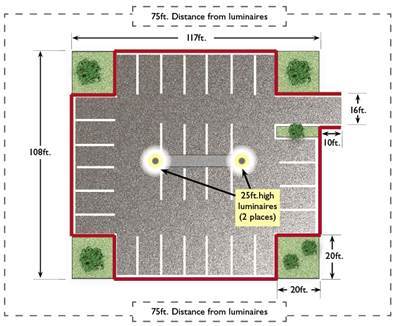
Image: California Energy Commission
Answer
The poles are 40 ft. apart, and using the 10 times mounting height rule, the illuminated area can be as large as 250 ft. by 290 ft. The boundary of this illuminated area extends beyond the edges of the parking lot as well as the entrance driveway, so the entire paved area is considered illuminated. The landscaped island in middle and peninsula below the entrance driveway are less than 10 ft. wide, so they are included as part of the illuminated area. The landscaped cutouts (20 x 20 ft.) in the corners of the parking lot are bound by pavement on only two sides so they are not included. The total paved area is 11,196 sq. ft. [(12,636 sq. ft. + 160 sq. ft. (driveway) – 1,600 sq. ft (cutouts)].
Two allowances make up the general hardscape allowance: Area and Initial. All allowances are based on a Lighting Zone 3 and found in (Table 170.2-R of the Standards).
The area wattage allowance is equal to 425.4 W.
The initial wattage allowance (IWA) is 400 W for the entire site.
The sum of these two allowances gives a total wattage allowance for the site of 825.4 W.
The calculations are tabulated below.
|
Type of Allowance
|
Allowance
|
Area/Perimeter Value
|
Power Allowance
|
|
Initial
|
400 W
|
-
|
400 W
|
|
Area
|
0.038 W/sq. ft.
|
11,196 sq. ft.
|
425.4 W
|
|
-
|
-
|
Total Power Allowance:
|
825.4 W
|
Source: California Energy Commission
The Standards includes a lighting power provision for narrow band spectrum light source application to minimize the impact of electric light on local, active professional astronomy or nocturnal habitat of specific local fauna. The provision is in the format of lighting power multiplier as specified on the footnote of Table 170.2-R (footnote 2). This provision is consistent with the requirement for narrow band spectrum light sources in nonresidential outdoor lighting.
The lighting power allowances for specific applications provide additional lighting power that can be layered in addition to the general hardscape lighting power allowances, as applicable. Some portions of the site may fit use categories that permit the inclusion of an additional lighting allowance for that portion of the site. These specific applications are detailed in Table 1166 (Table 170.2-S of the Energy Code). Additional allowances for specific applications can be per application, per hardscape area, per specific application unit length, or per specific application area.
As noted previously, all these additional allowances are use it or lose it allowances and cannot be traded between applications or to general hardscape lighting. However, general hardscape lighting allowance may be traded to supplement these specific applications.
| Lighting Application WATTAGE ALLOWANCE PER APPLICATION. Use all that apply as appropriate. | Lighting Zone 0 | Lighting Zone 1 | Lighting Zone 2 | Lighting Zone 3 | Lighting Zone 4 |
| Building Entrances or Exits. Allowance per door. Luminaires must be within 20 ft. of the door. | Not applicable | 9 watts | 15 watts | 19 watts | 21 watts |
| Primary Entrances to Senior Care Facilities Allowance per primary entrance(s) only. Primary entrances are entrances that provide access for the general public. This allowance is in addition to the building entrance or exit allowance above. Luminaires must be within 100 ft. of the primary entrance. | Not applicable | 20 watts | 40 watts | 57 watts | 60 watts |
| ATM Machine Lighting. Allowance per ATM machine. Luminaires must be within 50 ft. of the dispenser. | Not applicable | 100 watts for first ATM machine, 35 watts for each additional ATM machine. | 100 watts for first ATM machine, 35 watts for each additional ATM machine. | 100 watts for first ATM machine, 35 watts for each additional ATM machine. | 100 watts for first ATM machine, 35 watts for each additional ATM machine. |
| Lighting Application WATTAGE ALLOWANCE PER HARDSCAPE AREA (W/sq. ft.). May be used for any illuminated hardscape area on the site. | Lighting Zone 0 | Lighting Zone 1 | Lighting Zone 2 | Lighting Zone 3 | Lighting Zone 4 |
| Hardscape Ornamental Lighting. Allowance for the total site illuminated hardscape area. Luminaires must be rated for 100 watts or less and be post-top luminaires, lanterns, pendant luminaires, or chandeliers. | Not applicable | No Allowance | 0.007 W/sq. ft. | 0.013 W/sq. ft. | 0.019 W/sq. ft. |
| Lighting Application WATTAGE ALLOWANCE PER SPECIFIC AREA (W/sq. ft.). May be used as appropriate provided that only one is used for a given area (i.e., provided that two allowances are not applied to the same area). | Lighting Zone 0 | Lighting Zone 1 | Lighting Zone 2 | Lighting Zone 3 | Lighting Zone 4 |
| Building Façades. Only areas of building façade that are illuminated must qualify for this allowance. Luminaires qualifying for this allowance must be aimed at the façade and must be capable of illuminating it without obstruction or interference by permanent building features or other objects. This allowance calculation must not include portions of the building façades within 20 ft. of residence bedroom windows. | Not applicable | No Allowance | 0.100 W/sq. ft. | 0.170 W/sq. ft. | 0.225 W/sq. ft. |
| Canopies and Tunnels. Allowance for the total area within the drip line of the canopy or inside the tunnel. Luminaires must be located under the canopy or tunnel. | Not applicable | 0.057 W/sq. ft. | 0.137 W/sq. ft. | 0.270 W/sq. ft. | 0.370 W/sq. ft. |
| Outdoor Dining. Allowance for the total illuminated hardscape of outdoor dining. Outdoor dining areas are hardscape areas used to serve and consume food and beverages. Qualifying luminaires must be within 2 mounting heights of the hardscape area of outdoor dining. | Not applicable | 0.004 W/sq. ft. | 0.030 W/sq. ft. | 0.050 W/sq. ft. | 0.075 W/sq. ft. |
| Special Security Lighting for Retail Parking and Pedestrian Hardscape. This additional allowance is for illuminated retail parking and pedestrian hardscape identified as having special security needs. This allowance must be in addition to the building entrance or exit allowance. | Not applicable | 0.004 W/sq. ft. | 0.005 W/ft² | 0.010 W/ft² | No Allowance |
| Security Camera. This additional allowance is for the illuminated general hardscape area. This allowance must apply when a security camera is installed within 2 mounting heights of the general hardscape area and mounted more than 10 ft. away from a building. | Not applicable | No Allowance | 0.018 W/ft² | 0.018 W/ft² | 0.018 W/ft² |
Source: California Energy Commission
Most of these allowances are comparable to the same allowance in the nonresidential portions of the code. See section 6.5.3 for more details. The one category of allowance that differs is building façade lighting.
Building façade lighting is permitted in a similar manner as the nonresidential sections of the code, however, multifamily buildings have a specific stipulation to the façade lighting allowance that the allowance is not permitted to be counted in areas of the façade that are within 20 feet of a bedroom window. This means that portions of the building façade will either have no façade lighting or the allowance will be smaller because of the excluded area for the allowance.
See Section 6.5.4-A detailed discussion of building façade lighting.
Example 11-44: Power Allowance for Multifamily Building Façades
Question
Portions of the front façade of a proposed multifamily building in Lighting Zone 3 are going to be illuminated. The front wall dimensions are 80 ft. wide by 50 ft. tall. There is a column of 6 ft. wide bedroom windows, aligned vertically, in the center façade. All areas of the façade will be illuminated by façade lighting, except those areas of the façade near bedroom windows that are excluded from the façade lighting allowance. What is the allowed front façade lighting power?
Answer
The gross wall area is 4,000 sq. ft. (80 x 50). However, we must subtract all those areas that are within 20 ft. of a bedroom window.
The areas not eligible for power calculations include the 6 ft. width of the column of bedroom windows, plus 20 ft. of width on either side of the windows, or a total of 46 ft. of width:
46 ft. of width on or near bedroom windows x 50 ft. façade height = 2,300 sq. ft.
The net wall area used to determine façade lighting allowance: 4,000 sq. ft. – 2,300 sq. ft. = 1,700 sq. ft.
From Table 11-67 (Table 170.2-S of the Standards), the allowed façade lighting power density in Lighting Zone 3 is 0.17 W/ sq. ft.
The calculated allowed power based on net wall area is 1,700 sq. ft. x 0.17 W/ sq. ft. = 289 W.
The allowed power is therefore the smaller of actual wattage used for façade lighting or 289 W.
Additions to dwelling units must meet all applicable mandatory dwelling unit lighting requirements as described in Section 11.8.2. For alterations to dwelling units, any existing lighting may stay in place, but all newly installed lighting must meet the mandatory dwelling unit lighting requirements.
For details on lighting requirements for additions and alterations to multifamily common use areas, please refer to Section 5.10.
For details on lighting requirements for additions and alterations to multifamily outdoor areas, please refer to Section 6.6.
This case example considers a new two-story garden style multifamily building in Burbank, California (Climate Zone (CZ) 9) . This is a sample project created for training purposes, and it consists of 7,216 ft² of conditioned floor area with eight dwelling units and no common use areas. The tables below provide details about the proposed lighting design and the possible compliance options for meeting the Energy Code which includes mandatory and prescriptive requirements for indoor and lighting outdoor lighting.
Note that the mandatory requirements in §160.5(a) govern the lighting installed inside the dwelling units and the outdoor lighting that is controlled from within the dwelling units.
On the other hand, outdoor lighting for the overall building site must meet prescriptive wattage allowances in §170.2(e)6 plus mandatory lighting controls and acceptance testing requirements in §160.5(c) and (e).
The outdoor lighting for the overall site must also meet the prescriptive wattage allowance. The outdoor lighting for the overall building site consists of two pole lights at 35 watts each for a total of 70 watts. Since the prescriptively allowed hardscape lighting for the site is 386 watts, the site lighting complies with the Energy Code.
The figure below shows the outdoor lighting on the site as well as the lighting at the entry to the dwelling unit.
Figure 77: Garden Style Multifamily CASE Example: Outdoor Luminaires located on site (left); Dwelling Unit Entry Light and the entry switch on/off switch located inside the unit (right)
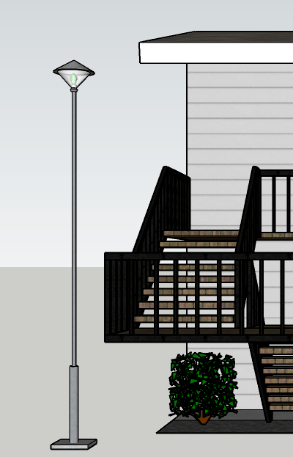

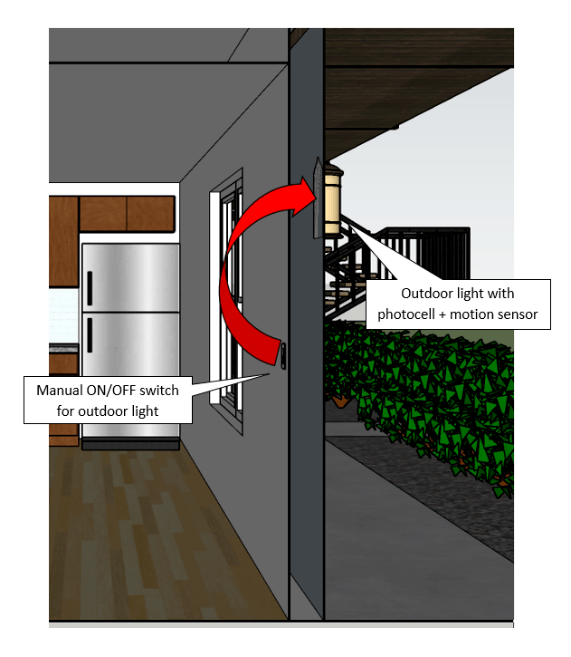
Image: IOU CASE Team
The table below provides an overview of the compliance to the mandatory and prescriptive requirements for this case study.
Item: Dwelling Unit Lighting | Proposed Design | Applicable Mandatory Requirements | Applicable Prescriptive Requirements | Compliance Option |
Luminaires (light fixtures) | All rooms: JA8 dimmable LED fixtures All fixtures are controlled by on/off switch plus dimmers. | Prescriptive: None | 1.The proposed luminaires meet the efficacy requirements of Table 160.5-A. 2.Besides the efficacy requirements, there could be applicable luminaire related requirements depending on the luminaire types (screw based luminaires, recessed luminaires, and enclosed luminaires). | |
Bathroom Lighting | Bathrooms: Light in exhaust fan unit controlled with vacancy sensor | §160.5(a)1 and 160.5(a)2E | Prescriptive: None | 1.The proposed design meet the requirement of §160.5(a)2E. 2.The code requires at least one bathroom luminaire must be controlled by an occupancy sensor or vacancy sensor with automatic-off functionality. If there is a second luminaire installed in the bathroom, it is optional for the luminaire to meet |
Entry Door Lighting outside the unit | One 25 watt LED light installed by the entry door to each residence unit, motion sensor and photocontrol plus on/off switch controlled from inside each dwelling unit. | 1. Luminaire efficacy per Table 160.5-A. 2.§160.5(a)3A requires manual on/off combined with photocell plus motion sensor or auto time switch OR astronomical time clock. | Prescriptive: None | 1.The proposed luminaire meets the efficacy requirements of Table 160.5-A. 2.The proposed photocontrol plus on/off switch and motion sensor control meet the requirements of §160.5(a)3A . |
Source: California Energy Commission
Outdoor Lighting System | Proposed Design | Applicable Mandatory Requirements | Applicable Prescriptive Requirements | Compliance Approach/option |
Outdoor Lighting Zone (LZ) | LZ2 | LZ2 per Table 10-114-A for all multifamily project locations | Prescriptive: None | N/A |
Outdoor Luminaires (fixtures) | Two 16 ft high light poles with one 35 watt, 90 lumen lamp per fixture. | Backlight, Uplight, and Glare (BUG) Shielding if ≥ 6,200 initial lumens. Lighting Controls: - Daylight Availability, - Motion Sensors if > 40 watts/fixture and within 24 ft of ground, - Automatic Scheduling | Hardscape area: 1,200 ft² General hardscape lighting allowance = 0.03 W/ft² x 1,200 ft² = 36 W Initial lighting Allowance = 350 W Total Allowance: 36 W + 350 W = 386 W | 1.The luminaire BUG requirements do not apply to this lighting design as the luminaires are below the code trigger threshold on initial lumens. 2.The proposed outdoor lighting power is below the maximum allowed lighting power. Therefore, the proposed outdoor luminaires meet the code requirements. |
Outdoor Lighting Controls | The light poles are controlled by programmable astronomical time clock. The entire site of 1,200 ft² hardscape including the outdoor lighting is operated by a property management firm. | Lighting Controls: - Daylight Availability, - Motion Sensors if > 40 watts/fixture and within 24 ft of ground, - Automatic Scheduling | Prescriptive: None | The motion sensors requirements do not apply to this lighting design as the luminaire rated wattage (35W) is below the code trigger threshold (40W). The proposed programmable astronomical time clock meets the daylight availability requirement and automatic scheduling requirement. |
Verifications: | Outdoor lighting will have ATT verification for astronomical time clocks | Mandatory ATT for site lighting controls | Prescriptive: N/A | Outdoor lighting controls acceptance test is required. |
Source: California Energy Commission
This Mid-Rise Multifamily Case Study covers a new five-story multifamily building in Sacramento, California (Climate Zone (CZ) 12). This is a sample project created for training purposes, and it includes 112,044 ft² of conditioned floor area with 88 dwelling units, shared residential corridors, laundry rooms, fitness center and lounge, plus ground floor retail. The tables below provide details about the proposed lighting design and the possible compliance options for meeting the Energy Code which includes mandatory and prescriptive requirements for indoor and lighting outdoor lighting.
General Information and Total Conditioned Floor Area | Applicable Lighting Code Requirements (mandatory) | Applicable Lighting Code Requirements (Prescriptive) |
New five-story mid-rise multifamily building, 88 dwelling units, common use areas, ground floor retail, Sacramento, CA. Conditioned Floor Area (CFA) as follows: | ||
Dwelling Units: 78,384 ft² | None. | |
Multifamily Common Service Areas: 17,487 ft² | §170.2(e)1 thru 4. | |
Nonresidential: 16,173 ft² | Requirements for lighting in nonresidential spaces in mixed use buildings are covered by nonresidential lighting requirements. (Refer to Chapter 5.) | Requirements for lighting in nonresidential spaces in mixed use buildings are covered by nonresidential lighting requirements. (Refer to Chapter 5.) |
Total: 112,044 ft² | (blank space) | (blank space) |
Source: California Energy Commission
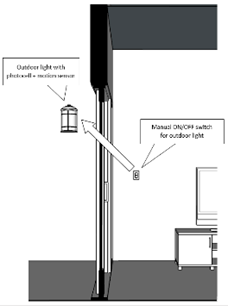
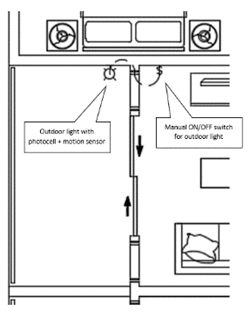
|
Outdoor Lighting System
|
Proposed Design
|
Applicable Mandatory Requirements
|
Applicable Prescriptive Requirements
|
Compliance Option
|
|
Dwelling Units: Indoor Lighting
|
All rooms: JA8 dimmable LED fixtures with on/off switch plus dimmers,
|
Dwelling Units: Indoor Lighting
|
All rooms: JA8 dimmable LED fixtures with on/off switch plus dimmers,
|
|
|
Dwelling Units: Outdoor Lighting
|
Luminaire Efficacy per Table 160.5-A,
|
Dwelling Units: Outdoor Lighting
|
Source: California Energy Commission
|
Outdoor Lighting System
|
Proposed Design
|
Applicable Mandatory Requirements
|
Applicable Prescriptive Requirements
|
Compliance Option
|
|
MF Common Service Area: Indoor Lighting
|
Common service areas designed to meet prescriptive wattage allowances and mandatory controls
|
§160.5(b) : Lighting Controls:
- Manual On/Off - Multi-level - Automatic Shut Off - Automatic Daylighting -Demand Responsive Controls |
Meet allowed wattage requirements of §170.2(e) for each space type
|
Mandatory: Yes Prescriptive: Yes
|
|
Retail: Indoor Lighting
|
Indoor lighting for retail spaces to comply with Prescriptive wattage allowances and Mandatory controls as tenant improvements on occupancy
|
§130.1 : Lighting Controls:
- Manual On/Off - Multi-level - Automatic Shut Off - Automatic Daylighting -Demand Responsive Controls |
Meet allowed wattage requirements of § for each space type
|
Mandatory and Prescriptive compliance to be shown as tenant improvements under separate permit
|
|
Verifications:
|
Common service area lighting, retail indoor lighting will have ATT verification for lighting controls
|
Mandatory ATT for lighting controls
|
N/A
|
Mandatory: Yes Prescriptive: N/A
|
Source: California Energy Commission
|
Outdoor Lighting System
|
Proposed Design
|
Applicable Mandatory Requirements
|
Applicable Prescriptive Requirements
|
Compliance Option
|
|
Site: Outdoor Lighting Zone (LZ)
|
LZ2
|
LZ2 per Table 10-114-A for all multifamily project locations
|
None.
|
|
|
Site: Outdoor Lighting
|
Controlled by management and serves entire site, 7,274 ft² hardscape,
|
Site: Outdoor Lighting
|
Controlled by management and serves entire site, 7,274 ft² hardscape,
|
Site: Outdoor Lighting
|
|
Verifications:
|
Site lighting will have ATT verification for programmable astronomical time clock
|
Mandatory ATT for lighting controls
|
N/A
|
Mandatory: Yes
|
Source: California Energy Commission
Figure 79: Outdoor Lighting for CASE Example 2: Sideview of an Outdoor Luminaire at the Multifamily Building Site (top left); Outdoor Luminaires for Walkway Lighting (top right); Outdoor Luminaires for Courtyard Lighting (bottom)
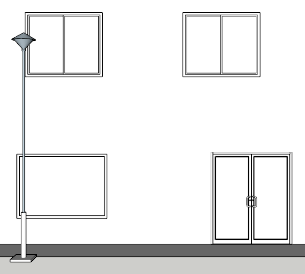
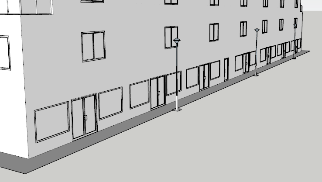
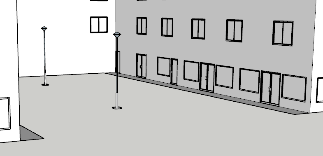
This mixed use mid-rise building has separate indoor lighting requirements for the dwelling units compared to the multifamily common service areas and nonresidential retail spaces, and it also has different requirements for the outdoor lighting for the dwelling unit balconies versus the outdoor lighting for the building overall.
The lighting installed inside the dwelling units and the outdoor lighting that is controlled from within the dwelling units must comply with luminaire efficacy and mandatory lighting control requirements.
All of the proposed dwelling unit lighting has been designed to meet applicable mandatory requirements, so all the indoor and outdoor dwelling unit lighting complies with the Energy Code without any other requirements.
The outdoor lighting for the overall building site needs to comply with mandatory outdoor lighting controls, acceptance testing, and prescriptive outdoor requirements, and must also meet the prescriptive outdoor lighting power allowance requirements. The site lighting consists of nine pole lights at 35 watts each for a total of 315 watts. The prescriptively allowed hardscape lighting power allowance for the site is 568 watts, so the site lighting complies with the Energy Code.
Indoor lighting for the multifamily common service areas and nonresidential retail spaces must comply with mandatory indoor lighting control, acceptance testing, and prescriptive indoor lighting power allowance requirements. The prescriptive lighting power allowances for multifamily common service areas versus nonresidential retail spaces are very similar, but they are found in different sections of the Energy Code.
One common situation for retail spaces in buildings like this is that the lighting is not fully permitted or installed until new tenants move in.


